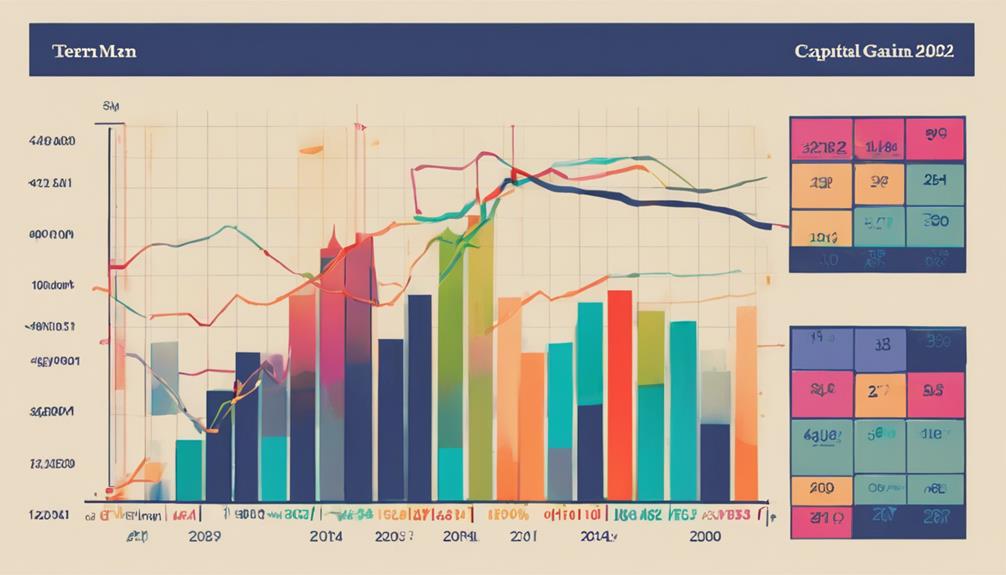As tax season approaches, it's essential to understand the nuances of capital gains taxes. You'll need to know how these taxes are calculated, what holding periods apply, and which exemptions or exclusions you may qualify for. Properly managing your capital gains can substantially impact your overall tax liability – and your investment strategy for the year ahead. Whether you're new to investing or a seasoned trader, the details in this guide could make all the difference when it comes to maximizing your returns and minimizing what you owe the IRS. Let's immerse ourselves and guarantee you're fully prepared for 2024.
Key Takeaways
- Understand the basics of capital gains taxation, including the distinction between short-term and long-term gains and their respective tax rates.
- Familiarize yourself with the various exemptions and exclusions that can reduce your capital gains tax liability, such as the primary residence exclusion.
- Learn how to properly calculate your cost basis and holding period to determine the applicable tax rate for your investment gains.
- Stay updated on the latest capital gains tax thresholds and rates, as they may change for the 2024 tax year.
- Explore strategies like asset location and tax-efficient investing to minimize the impact of capital gains taxes on your investment portfolio.
Definition and Basics of Capital Gains Taxes

A capital gain occurs when you sell an asset, such as stocks, real estate, or other investment property, for more than you originally paid for it. This "gain" in value is subject to capital gains taxes, which can have a significant impact on your overall tax liability. The tax rate you'll pay on your capital gains depends on your marginal tax rates, as well as the length of time you held the asset – known as your investment horizon.
Generally, if you've held the asset for more than a year, you'll be subject to the long-term capital gains tax rate, which is typically lower than the rate for short-term capital gains (assets held for a year or less). Understanding the nuances of capital gains taxes is vital as you plan your investment strategy and manage your tax obligations. By being aware of the rules and how they may affect your specific situation, you can make more informed decisions about when and how to sell your assets.
Calculating Capital Gains Tax Liability
To calculate your capital gains tax liability, you'll first need to determine your cost basis. This is the original price you paid for the asset plus any costs associated with the purchase. You can then apply any applicable exclusions, such as the capital gains tax exemption for the sale of a primary residence, to reduce your taxable gain.
Determining Cost Basis
Calculating your capital gains tax liability begins by determining the cost basis of your investment. The cost basis is the original price you paid for the shares, plus any commissions or fees you incurred when you bought them. This is known as your adjusted cost basis.
When you sell your investment, the difference between the sale price and your adjusted cost basis is your capital gain or loss. To calculate this accurately, you'll need to know the specific date you purchased the shares. The shares purchase date is pivotal, as it determines which tax rate applies to your capital gains.
If you've held the investment for more than a year, you'll generally pay a lower long-term capital gains tax rate. However, if you've held it for less than a year, it's considered a short-term capital gain, which is taxed at your regular income tax rate. Keeping meticulous records of your shares purchase date is essential for determining your cost basis and capital gains tax liability.
Applying Exclusions
Fortunately, the IRS offers certain exclusions that can help reduce your capital gains tax liability. The primary residence exclusion allows you to exclude up to $250,000 ($500,000 for married couples filing jointly) of capital gains from the sale of your primary residence, as long as you've owned and used it as your main home for at least two of the last five years.
Another valuable exclusion is the tax-deferred exchange, also known as a 1031 exchange. This allows you to defer capital gains taxes when you sell an investment property and reinvest the proceeds into a similar property. By properly structuring a 1031 exchange, you can postpone paying taxes on your capital gains until you eventually sell the replacement property.
It's important to understand the specific requirements and limitations of these exclusions to guarantee you're maximizing the tax benefits. Consulting with a tax professional can help you navigate the complexities and make certain you're taking advantage of all the available exclusions.
Short-Term Vs. Long-Term Capital Gains

Capital gains can be classified into two main categories: short-term and long-term. Short-term capital gains refer to assets held for less than one year, while long-term capital gains are from assets held for more than a year. The tax treatment of these two types of capital gains differs meaningfully.
Short-term capital gains are taxed at your ordinary income tax rate, which can be as high as 37% in 2024. On the other hand, long-term capital gains are generally taxed at a lower rate of 0%, 15%, or 20%, depending on your taxable income. This makes long-term capital gains a more tax-efficient way to grow your wealth.
Understanding the holding period is pivotal for tax planning and strategies like tax loss harvesting. By carefully timing the sale of your assets, you can minimize your tax liability and maximize your investment returns. Stay informed about the latest capital gains tax rules to make the most of your investments in 2024 and beyond.
Exemptions and Exclusions for Capital Gains
Do you know that there are certain exemptions and exclusions that can help reduce the amount of capital gains taxes you owe? One of the most common is the qualified small business stock (QSBS) exemption. If you've held QSBS for more than five years, you may be able to exclude up to $10 million or 10 times your initial investment from capital gains taxes.
Another important exemption is the primary residence exemption. If you've lived in your home as your primary residence for at least two of the last five years, you can exclude up to $250,000 ($500,000 for married couples filing jointly) of the capital gains from the sale of your home.
| Exemption/Exclusion | Description |
|---|---|
| Qualified Small Business Stock (QSBS) | Up to $10 million or 10x initial investment exempt if held >5 years |
| Primary Residence | Up to $250,000 ($500,000 for married couples) exempt if lived in >2 of last 5 years |
Understanding these exemptions and exclusions can help you minimize your capital gains tax liability and keep more of your hard-earned money.
Reporting Capital Gains on Tax Returns

Once you've calculated your capital gains, you'll need to document them on your tax return. This involves listing your total capital gains and losses on Schedule D, which is attached to your Form 1040. Be sure to accurately record the date you sold the asset, the purchase price, and the sale price. If you've engaged in tax loss harvesting, you'll need to report those losses as well, as they can be used to offset your capital gains.
Don't forget to report any assets you've gifted. Even if you didn't receive any money from the transaction, you'll need to report the fair market value of the gifted asset as a capital gain. Proper reporting guarantees you pay the right amount of taxes and avoid any issues with the IRS.
Capital Gains Tax Rates and Thresholds
The tax rates and thresholds for capital gains can substantially impact your total tax liability. For 2024, the capital gains tax rates are 0%, 15%, and 20%, depending on your taxable income and filing status. If your taxable income falls below $44,000 (or $88,000 for joint filers), you'll pay 0% on your capital gains. Between $44,000 and $492,000 (or $88,000 and $553,000 for joint filers), the 15% rate applies. Anything above those thresholds is subject to the 20% rate.
Effective tax planning is essential to minimize your capital gains tax burden. Consider diversifying your investment portfolio to take advantage of the different tax rates. For instance, you could hold some assets that qualify for the 0% rate and others for the 15% or 20% rates. This can help you optimize your overall tax situation. Remember, staying informed about the latest capital gains tax thresholds and rates is key to making informed investment decisions.
Impact of Capital Gains Taxes on Investments

Capital gains taxes can have a significant impact on the performance and growth of your investments. When you sell an asset for a profit, the government will take a cut of those gains through capital gains taxes. This can eat into your investment returns, making it harder to reach your financial goals.
That's why it's essential to evaluate the impact of capital gains taxes when building your investment portfolio. Diversification is key – by spreading your investments across different asset classes, you can potentially offset capital gains in one area with losses in another. Additionally, employing tax-efficient investment strategies, like holding assets long-term or utilizing tax-advantaged accounts, can help minimize the tax bite.
Strategies to Minimize Capital Gains Taxes
Fortunately, there are several strategies you can employ to minimize the impact of capital gains taxes on your investments. One effective approach is tax-loss harvesting. This involves selling investments that have declined in value to offset the capital gains from your profitable trades. Doing so can lower your overall tax burden.
Another strategy is to carefully allocate your assets. By diversifying your portfolio across different asset classes, you can reduce the likelihood of large capital gains in any one area. This can be particularly beneficial if you hold investments that appreciate considerably over time.
Additionally, consider holding on to your investments for the long term. Capital gains taxes are generally lower for assets held for more than a year. By taking a patient, long-term approach, you can potentially reduce the taxes you owe on your investment gains.
Considerations for Real Estate Capital Gains

One essential consideration for real estate capital gains is the impact of depreciation. When you sell an investment property, any depreciation deductions you've claimed over the years will be "recaptured" and taxed as ordinary income. This can substantially increase your tax bill, so be sure to factor it in when calculating your potential capital gains.
Another key consideration is the use of 1031 exchange strategies. By conducting a 1031 exchange, you can defer capital gains taxes when selling an investment property and reinvesting the proceeds into a new property. This allows you to grow your real estate portfolio without an immediate tax burden. Just be mindful of the strict timelines and requirements for a successful 1031 exchange.
Ultimately, maneuvering the intricacies of real estate capital gains can be challenging, but understanding the tax implications and leveraging strategies like depreciation recapture and 1031 exchanges can help you minimize the bite out of your profits.
Recent Changes and Upcoming Developments
Recently, the Tax Cuts and Jobs Act of 2017 introduced several changes that impact real estate capital gains. One key change is the reduction of the top federal capital gains tax rate from 20% to 15%. This lower rate applies to the sale of investment properties, like rental homes or commercial buildings. However, keep in mind that state-level capital gains taxes may still apply, so your total tax bill could be higher.
Looking ahead to 2024, upcoming reporting requirements may also affect how you record and report real estate capital gains. The IRS is expected to introduce new forms and filing procedures, so stay informed and work closely with your tax professional. These recent tax policy changes and upcoming reporting requirements highlight the importance of proactive planning to minimize your capital gains tax liability. Understanding the evolving landscape can help you make informed decisions about buying, holding, or selling real estate investments.
